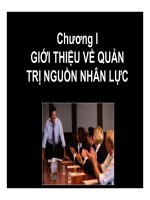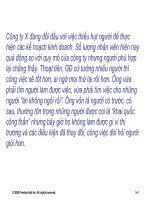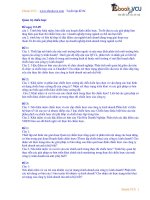KT QUẢN TRỊ THUYẾT TRÌNH 1 CHƯƠNG 3
Bạn đang xem bản rút gọn của tài liệu. Xem và tải ngay bản đầy đủ của tài liệu tại đây (3.45 MB, 48 trang )
Suitable for
categories
business and
personal
presentation, eaque
ipsa quae ab illo
inventore veritatis
et quasi architecto
beatae
HỌ VÀ TÊN
DANH
SÁCH
NHÓM 6
MSSV
Nguyễn Vương Bảo
14027311
Nguyễn Thị Tuyết Mai
14017491
Nguyễn Thị Ngọc Anh
14013901
Hồ Phước Quang Đức
14033801
Trịnh Thành Hưng
Category in Chapter 3:
3.1. Job- order costing – an overview
3.2. Job- order costing – an example
3.3. Job- order costing- the flow of costs
3.4. Schedules of cost good manufactured cost of goods sold
3.5. Underapplied and overapplied overhead – acloser look
3.6. Job- order costing in the service companies
3.7. Managing Job cost in a service business
3.1. JOB- ORDER COSTING – AN OVERVIEW
• Under absorption costing, product costs include all manufacturing costs. Some
manufacturing costs, such as direct materials, can be directly traced to particular
products.
Job- order costing is used in situations where many
different products are produced each period. It is
also used to extensively in service industries. For
example, hospital, lawfirms, movie studios, etc, all
use a variation of job-order costing to accumulate
costs.
3.2. JOB- ORDER COSTING – AN EXAMPLE
• To introduce job-order costing, we will follow a specific job as it progresses through the
manufacturing process.
Manufacturing Cost
Direct Materials
Direct Labor
Manufacturing Overhead
The meeting : The company’s top manager
Marc White
Jean Most
(The
company’s
president)
Debbie
Turner
(The
production
manager)
(The company
controller)
David
Cheung
(The marketing
manager)
Staffs
3.2.1. Measuring direct materials cost
• The blueprints submitted by Loops Unlimited indicate that each experimental coupling will
require 3 parts that are classified as direct materials: Two G7 Connectorsandone, M46
Housing
• This is a custom product that is being made for the first time, but if this were one of the
company’s standard products, it would have an established bill of material.
Bill of
material
Is the document that lists the type and quantity of
each type of direct material needed to complete a
unit of product
Materials Requisition Form
Materials Requisition Number: 14873
Date : March 2
Job Number to Be Charged
2B47
Department
Milling
Decription
Quantity
Unit Cost
Total Cost
M46 Housing
2
$ 124
$248
G7 Connector
4
$ 103
$412
3.2.2 JOB COST SHEET
• After a production order has been issued, the Accounting Department’s job-order
costing software system automatically generates a job cost sheet
A job cost
sheet
Records the materials,
labor, and manufacturing
overhead cost charged to
that job
JOB COST SHEET
Job number: 2B47
Date Initiated: 02-03
Department: Milling
Date completed:
Item: Special order coupling
Units completed:
For stock
Direct Material
Direct labor
Manufacturing Overhead
Req.No.
Amount
Ticket
Hours
Amount
14873
$660
843
5
$45
Cost Summary
Hours
$
Direct Labor
Manufacturing Overhead
Total Cost
Unit Product Cost
Amount
Units shipped
Date
Direct Materials
Rate
Number
Balance
3.2.3. Measuring direct labour cost
Direct labor consists of labor charges that are easily traced to a particular job.
Maintenance
DIRECT LABOR
Cleanup
Supervision
Many companies rely on computerized systems
to maintain employee time tickets
A completed time ticket is an
hour-by-hour summary of the
employee’s activities throughout
the day.
3.2.4. Computing predetermined overhead rates
Products cost include manufacturing overhead : direct materials and direct labor
manufacturing overhead needs to be recorded on the job cost sheet.
I
II
III
M.O is commonly assigned to products using a predetermined overhead rate
Predetermined
Overhead rated
=
Estimated total manufacturing overhead cost
Estimated total amount of the allocation base
Y = a + bX
Y= The estimated total M.O cost
a= The estimated total fixed M.O cost
b= The estimated variable M.O cost per
unit of the allocation base
X= The estimated total amount of the
allocation base
3.2.5 Applying manufacturing overhead
• The predetermined overhead rate is then used to apply overhead cost to jobs
throughout the period
• The progess of assigning overhead cost to jobs is called overhead application.
Overhead applied to particular job = Predetermined overhead rate x Amount of the base incurred by
Overhead applied to a particular job= Predetermined overhead rate x Actual direct labour-hour charged to the job
• 3.2.6
3.2.7. The need for a predetermined rate
A completed Job Cost Sheet
3.2.8. Choice of an allocation base for overhead cost
• A cost driver is a factor, such as machine-hours, beds occupied, computer time, or flighthours, that cause overhead costs.
• If the base in the predetermined overhead rate doesn’t “drive“ overhead costs, product
costs will be distorted.
• Most companies use direct labour-hours or direct labor cost as the allocation base for
manufacturing overhead
• Sophisticated automated
equipment has taken over
funtions that used to be
performed by workers. Because
the costs of acquiring and
maintaining such equipment are
classified as overhead, this
increases overhead while
decreasing direct labor
• Products are becoming more
sophisticated and complex and
are changed more frequently.
This increases the need for
highly skilled direct workers
such as engineers









